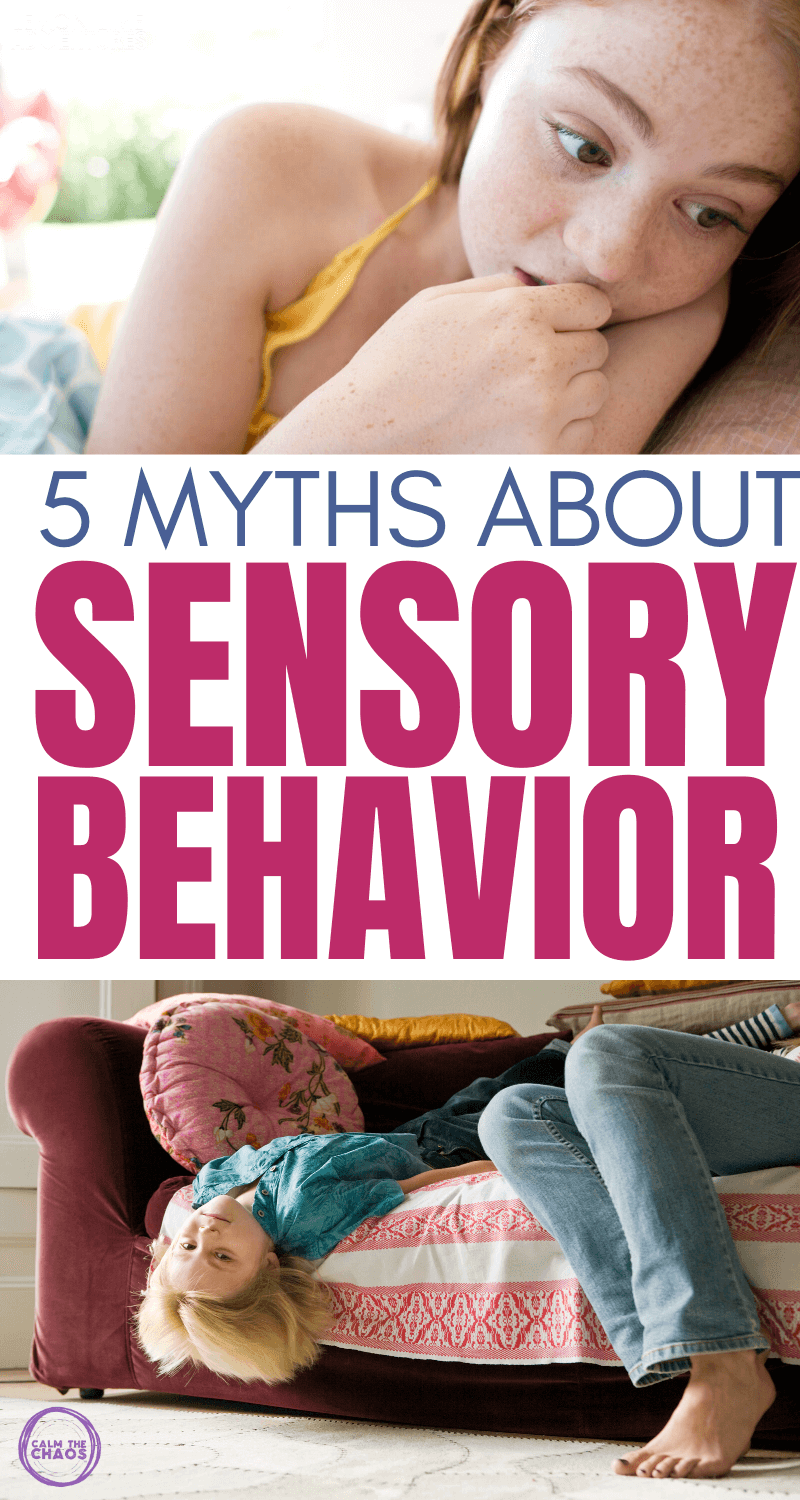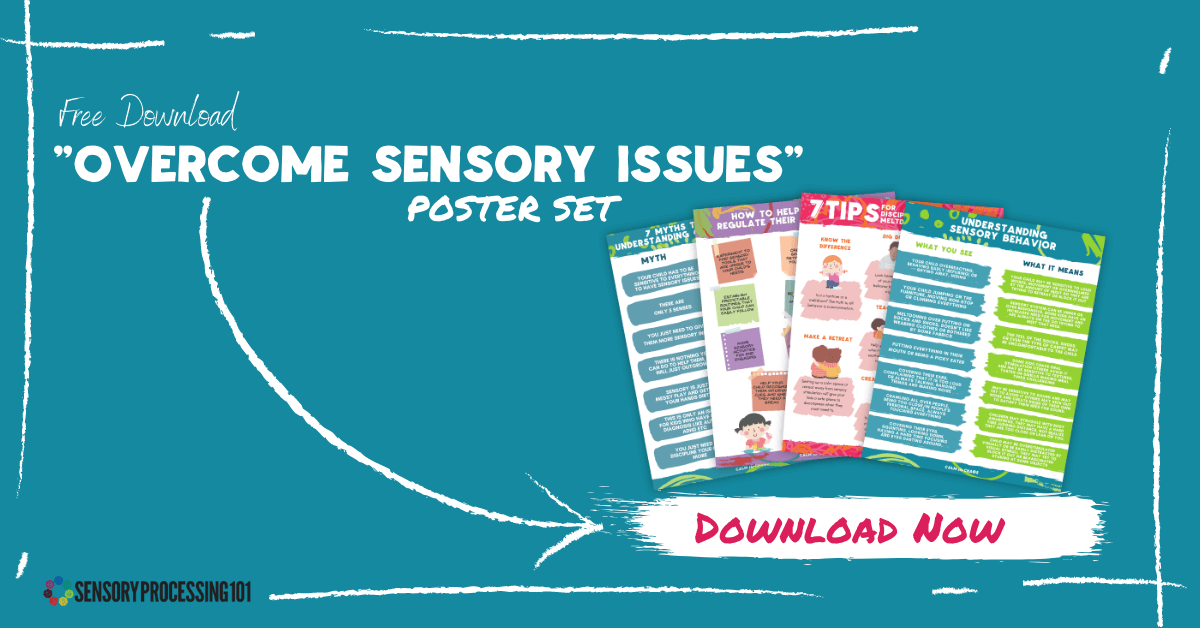Inside: If your kid’s strange behaviors leave you wondering if they are normal, sensory or behavior related, busting these 7 myths will unlock a deep understanding of their behavior.
Have you ever asked yourself “Is my kid normal”?
Does your child….
Struggle to sit still.
Are they constantly chewing on things.
Or jumping and climbing on the furniture.
Do they HATE wearing socks or shoes.
Or always complain that it’s TOO LOUD!!!
Maybe your child could win the prize for world’s pickiest eater?
Perhaps you’re dealing with tons of meltdowns. They’re not necessarily tantrums, but you just can’t seem to figure out exactly what is going on.
If you are struggling to decode your kids strange behaviors…
You are not alone!

I once had a child in my class who would sniff, lick, and then use her crayons.
Regardless of what kind of behavior you are dealing with, I want to tell you a secret…
Normal is OVERRATED!!!
My guess is, if you are reading this right now, your child is probably not normal.
And that’s ok.
Your child is unique and all those little quirks are what makes them, them!
So the first step in helping your child is to embrace them for who they are. Take a minute to truly understand them, embrace their individuality and change your lens about the way you see them.
To do this you will have to swap what you think about that behavior.
You need to…
- Stop seeing the behavior as “abnormal”.
- Stop focusing on the gap between your kid and other kids.
- Stop thinking about all the shoulda, woulda, coulda’s.
- And STOP COMPARING!
Instead I want you to embrace your child’s uniqueness.
I also want you to remember, no matter how strange or weird it may seem…
There is ALWAYS a reason for behavior.
My son once chewed his brother’s toenails off!!!
(Now that’s weird!!)
I struggled with sensory as a child too. I was constantly rubbing my clothes and my legs. Some people thought that something was wrong with me, or that I was obsessed with touching myself.
But that wasn’t it.
The behavior you are seeing on the surface, the picking, the nail biting, the chewing on things, the constant touching, the jumping or climbing on things… That is only part of the picture.
Under the surface there is a REASON for that behavior.
Remember, ALL behavior is communication.
Over the last 7 years I have discovered that there are six main reasons for behavior, but today I’m going to hone in on just one – SENSORY.
We’re going to take a look at behavior from a sensory perspective.
What is Sensory?
If you’ve never heard of sensory, that’s ok.
To tell you the truth, when I was teaching, before I started diving into this with my own son, I didn’t know what sensory was.
I’d never heard of it.
I just thought there were the five senses: sight, hearing, touch, smell and taste and that was it. But once I became aware of sensory and understood it, my world opened up!
If you already know about sensory, you likely have a child with some behaviors others would consider strange. You might have a kid who has a diagnosis, or maybe you know someone with sensory issues or you’re a professional who works with kids who have sensory needs.
Sensory is not something that’s taught in schools (even for teachers) and there are a lot of myths and misconceptions out there.
So in this post I’m going to share with you some common sensory behaviors and what they mean.
1. You might see a child that is overreacting, behaving badly.
They get labeled as the “bad kid” and might be refusing or shying away. This could mean they are sensitive to loud noises or they’re overwhelmed by the amount of things that are happening around them. They are trying to block it out or retreat away.
2. Perhaps your child is jumping on the furniture, moving non-stop or climbing everything.
Under the surface this indicates that their sensory systems are either over or under responsive. They have an increased need for movement and are trying to meet that need. We call this the vestibular sense. They could also be seeking proprioceptive input (body awareness) like tight squeezes, and pressure.
3. Maybe your child is having meltdowns over putting on their socks and shoes or they don’t like wearing clothes.
It could be that the feel of their socks and their shoes is incredibly uncomfortable to them due to a sensitive tactile sense.
4. Your child may put everything in their mouth or maybe they’re a picky eater.
Some kids crave oral stimulation while others avoid it at all costs. There’s so many sensitivities to texture, to taste or smells which can make mealtimes so incredibly difficult.

5. Perhaps your child is covering their ears and they’re complaining that it’s just too loud.
They could be sensitive to sound or and trying to avoid it. You notice they have meltdowns when things are loud. Or maybe they are the loud kid, constantly making noise (yes, they can be both!). Some kids seek out noise and make sounds because it can be incredibly calming and soothing for them.
6. You might have a kid who is crawling all over people, constantly too close, always in people’s personal space, or touching everything.
What’s really going on under the surface is the child might be struggling with their body awareness. They really need proprioceptive input or they might be unresponsive to that type of input so they don’t feel it or have that ability to recognize personal space. They might not even realize they are too close.
7. You might have a kid who covers their eyes or squints.
They look down, they don’t really make eye contact or have a hard time focusing. They’re constantly looking all over the place or they are addicted to screens. That child could be overstimulated visually or easily distracted. It also could be providing them input that is calming to their sensory systems in their body, so they are attracted to it. They watch the lights, are mesmerized by the movement and that could be a big thing.
As a kid I chewed all my pencils. I chewed all my jackets. I chewed my hair. I chewed my clothing. That was me growing up.
I thought I was weird and not normal.
But as I said, normal is overrated! 😉

So far we’ve covered a lot of ground. So quick recap…
First, I shared that “normal is overrated” so you can swap any negative thoughts you have around your kids behaviors.
Second, I’ve show you how to see these behaviors through a new lens. And I explained some common sensory behaviors that kids struggle with.
I’ve shown you how to look deeper, under the surface of the behavior, to gain insight and understanding.
Now I’d like to share how to gain a deep understanding of your child’s behaviors from the sensory lens.
7 Myths that Block Your Understanding of Sensory Behaviors
The third step is to take some time to TRULY UNDERSTAND sensory.
There is a lot of information out there.
If you search sensory processing, or sensory issues you will be inundated with information.
Some of it is fantastic, and some of it not. Some of it is amazingly clear, and some of it super confusing.
I’d like to dispel a few myths that are out there about sensory processing because these misunderstandings can really block us from being able to help our kids.
Myth #1: Your child has to be sensitive to everything to have sensory issues.
They have to cry over the smallest things.
They must not like to wear clothes.
They must be really picky about food.
Or hate loud noises.
But maybe your kid’s not over-sensitive?!
You’re not sure if they have sensory issues.

The truth is…
We all have sensory preferences.
We all have sensory needs.
And…
We all have DIFFERENT sensory needs and preferences.
The easiest way to describe this is by asking the question:
Do you love roller coasters?
When I say the word roller coaster, you might get excited! Maybe you can’t wait until theme parks open again!! For others, just the thought of going on a rollercoaster makes you queasy. I probably couldn’t pay you enough to even get on one!
That is a sensory preference.
If you are one of those people that love them, you have a need or desire for vestibular input. If your gut instinct is to run screaming in the other direction at the mere mention of a roller coaster, then you are likely over-responsive to vestibular input.
That’s why providing more sensory input doesn’t always work because if you don’t know the right input to use, it’s not going to help, and you could actually be adding to the problem.
So sometimes you need to remove sensory input.
MYTH #2: There’s nothing you can do to help.
They’ll just outgrow it eventually.
But this is not true. Over time your child might become aware of how people react to them. They might start or stop doing something because they are embarrassed, or always get in trouble.
But that need is probably still there.
We need to help our kids become self aware of their sensory needs and preferences, so they can advocate for themselves. So their needs CAN be met.
MYTH #3: Sensory is just messy play.
It’s just about getting your hands dirty and letting your kid play in mud or make slime.
Sensory is about meeting each of the senses, not just tactile.
Many kids don’t even like sensory play.
Now this next one is a big one. It’s the one I run into ALL THE TIME.

There is a huge myth that sensory is reserved for kids who have a diagnosis like ADHD or autism. It’s something that’s reserved for kids with a difference or disability.
We already talked about this one. Sensory is something we all deal with, because we all have sensory preferences. We all have likes and dislikes. We all have sensory needs.
MYTH #5: You just need to discipline your child more.
That your child is just behaving badly.
If you follow me, you already know that I see discipline as guidance and teaching. I don’t see discipline as punishment and rewarding.
So YES, you need to guide and teach your kids, but if there is a need that is not getting met, no matter how many rules you make about jumping on the furniture…
They’re still going to do it!
So the very last step I want to share for understanding sensory needs, is this:
(This one is really, really important!)
The last step is…
Empower Your Child with a Sensory Plan
Once you understand sensory, you can empower yourself and your child to make a plan to get those needs met.
There are so many great tools and strategies out there.
Things like…
- visual schedules,
- swings and fidgets.
- burrito wrap with your child,
- have them wear a headset,
- or push on the wall.
The possibilities are endless.
But it’s not about throwing spaghetti at the wall and just trying all these random strategies or handing your kids a bunch of tools and fidgets they just won’t use.

Instead, you need to take the time to really dig in and truly understand their unique preferences. You need to choose the RIGHT tools and strategies that work for them. So that their individual sensory needs, likes, and dislikes are met.
You also want to guide them to be able to read their own internal cues and notice when they have a need for a break or some movement. Recognize when they are overwhelmed. You want to empower them to become self aware, to identify their own sensory needs, and you want to work as a team to create a plan TOGETHER.
So if you kid is climbing all over strangers, screaming when you ask them to put on their shoes, touching EVERYTHING in sight, or chewing on the bedpost…
I want you to remember these 4 things:
- Normal is OVERRATED.
- There is ALWAYS a reason for behavior.
- Take the time to truly UNDERSTAND your unique child.
- EMPOWER your child and make a PLAN together.
More Resources To Understand Sensory
To help you remember some of these myths and understand some common sensory behavior, I’ve put together this amazing poster set on how to understand your child’s sensory struggles, help them regulate, and how to discipline sensory meltdowns.
These posters give you tips on decoding some common sensory behaviors so you can understand what your child’s strange behavior is really telling you!
There’s also a list of 7 common myths about sensory behavior. I dispel these misconceptions so you can gain a deeper understanding of what sensory really is.
Ok, you might be thinking… This all sounds great but…
- How do I deal with everyday struggles like bath time?
- What should I do when my child is having a meltdown?
- How do I create sensory strategies that are going to help my unique child?
And… - How do I actually get them to use the tools in the moment?
In my next few blog posts, I‘m going to be talking about just that! We’ll discuss how to deal with everyday struggles, from a sensory perspective.
I’ll also share how to create sensory strategies that are going to help your specific child and what to do in the moment when your child is in sensory overload and having a meltdown!
But right now, download your FREE Handle Any Sensory Challenge posters so you can start understanding sensory behavior, and getting your kids involved in making a plan!










My 8 year old chews her hair and pokes it in her ears!! Also her ears are super sensitive. Too much noise and she ends up shouting and everyone to shut up or cries and runs away and gets so angry…however she also yells! She bites her nails and had a soother until she was 4 so I know she is oral and I sucked my thumb until I was 16 so I get it.
Thank you Lemon Lime for all the helpful information. MY sensory grandson likes to paint his body. Strips down to under wear and sneak off with the paint. He is slowing down on episodes. Definitely sensory issues.
Wow! In the past year our son has had an OT evaluation due to sensory issues. He was diagnosed with ADHD and autism in September. He is 7 years old and it has been a long journey! He chews on things but his preferences have changed from paper to cloth to wood. He now chews on wooden blocks and we’re trying to find a safe alternative. I taught Sped PreK so I have an easier time understanding our son than my husband. THANK YOU for these articles and the amazing posters!
hello! I am wondering if we are able to print this session?
how do you get kids questioning? how to develop curiosity in them ???
My son seems to be more clam when he is on a computer playing games, other wise he is bouncing all over the place.